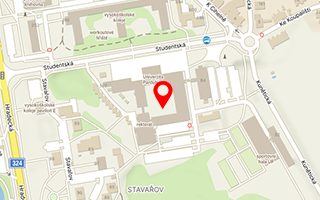Published: 24.05.2021
The rail traffic management in Europe will become more modern and safer thanks to the EGNOS satellite navigation system that has been used in civil aviation up to now. The use of satellite navigation for train positioning also involves reduction of operation costs. Aleš Filip, Associate Professor at the Faculty of Electrical Engineering and Informatics won the Galileo Masters 2020, a prestigious award in the field. “Thanks to using satellites for train positioning, it will be possible to have safety systems in places where it was not possible due to financial constraints, and the rail traffic safety was thus dependent on human error,” says Aleš Filip.
You have successfully completed the research into the use of the EGNOS navigation system. It took 10 years. Why so long?
Successful completion is not the right word. So far, we have only proposed a protocol. Originally, EGNOS was designed for civil aviation safety management. What we did was propose a way for adopting and approving something that was not originally designed in compliance with rail traffic standards to be used for rail traffic management as part of the European Railway Traffic Management System (ERTMS).
After many years without any specific progress, we have found the light at the end of the tunnel. We have made the way forward clear, and stressed the need for cooperation of all stakeholders on the European level. EGNOS certification, for which the University received the Galileo Masters 2020 Award, must be seen as one little piece of a jigsaw puzzle, which is a long and difficult journey leading to a safer and more modern rail traffic management in Europe.
How will the EGNOS system contribute to safer rail traffic?
What we propose is preparing a European safety manual for the use of EGNOS in rail traffic. The manual should provide a detailed description of how EGNOS can be safely integrated into the ERTMS. In fact, it will be a new European railway standard.
That is the light at the end of the tunnel?
Absolutely. It will show the system designers and people responsible for the industrial integration what steps need to be taken in order to design a product that will be safe and reliable enough to use EGNOS for safe train positioning. The manual will also help the authorities that will be responsible for the certification and approval of the train locator based on the EGNOS SoL (Safety of Life). The competent authorities include the European Union Agency for Railways (ERA), the European GNSS Agency (GSA) based in Prague, European Space Agency (ESA) and the European Commission.
Rail traffic safety is based on the knowledge of the train location and speed at a point in time. These variables may be determined with great precision using EGNOS. And this must also work in very challenging environments where the landscape or the buildings along the rail track are responsible for suboptimal conditions for signal transmission from the satellites to the train. Other factors that may compromise the safety include industrial or intentional interference with the signal along the tracks, sun eruptions affecting the transmission of the signal in the ionosphere etc. The designers and manufacturers of the system must bear all such factors in mind.
EGNOS, which includes a series of monitoring stations and other devices located virtually all around Europe, evaluates the quality of the GPS (or soon Galileo) signal and uses the geostationary satellite to inform the users of any issues that may occur. Safety measures preventing accidents must be adopted. That is how it works both in aviation and rail traffic.
Is it possible to quantify the safety standard required for rail traffic? Say that it fails not more than once a...
Say that a hazardous defect of the system resulting from incorrect positioning of the train that may lead to an accident, may occur once in 100 000 years or even less often. It is possible to visualise a time span of 100 years, but nearly impossible to visualise a time span of 1000 years. And absolutely impossible to visualise a time span of 100 000 years. Having said that, we must be able to prove that such a stringent safety standard is met thanks to using the EGNOS system. That is also one of the reasons why the journey to implementing satellite navigation in rail traffic is so long and far from being straightforward.
What methods were used to monitor rail traffic safety up to now?
Very costly trackside devices were necessary for train positioning. Safety systems are often obsolete, or even non-existent, on many local rail tracks. Satellite-based positioning systems are expected to reduce the costs of operation and rail maintenance, and make it possible to implement the safety systems in locations where it was not possible up to now due to financial constraints, and where the rail traffic safety was dependent on a human error. However, it is not only about train positioning in obsolete rail traffic safety systems, but also in the ERTMS system, where trackside balises are used. The aim is to replace the physical balises with virtual ones, which will be identifiable using EGNOS.
Can you describe the principle in more detail?
The ERTMS uses balises located in in the tracks, whose location is defined, for train positioning. Their shape often resembles that of a paving stone or a big box of chocolates. They are mostly yellow. There are often groups of two or more balises at one location. The distance between the balises is 100 metres on average, but it may much less or, on the other hand, as much as 2,5 kilometres depending on the situation.
The train engine is equipped with a balises reader which makes it possible to determine the precise location of the train. If EGNOS is used for train positioning, the safe location of the train will be determined on the basis of the EGNOS signal receiver and other on-board sensors. In this case, the location of the virtual balises is stored in the on-board computer. If the location of the train is consistent, with some margin, with the location of the virtual balise, the balise has been detected.
I can imagine that there is an international interest in your work. Who are your partners?
We have worked on the adoption and certification of EGNOS for the ERTMS in two international projects. Just like our European colleagues, we have found ourselves in a sort of a vicious circle over the past 10 years. On the one hand, EGNOS was used in aviation safety and was proved to be safe. On the other hand, the CENELEC standards prohibited the transfer of the proof of EGNOS safety developed for aviation to rail traffic since the principles behind aviation and rail traffic safety completely differ. The European Space Agency was in need of some solution.
Where is the system being tested abroad?
As a GSA expert, I attended ERTMS testing involving virtual balises detected at the GNSS base in Sardinia, Italy. The track from Cagliari to Decimomann was used for final testing in 2017. The project was conducted by Ansaldo STS, which has transformed into Hitachi Rail. That was not, however, the first case of implementing the ERTMS with a virtual balise. The very first case when ERTMS relied on GNSS was in West Australia and involved a 344-kilometre track from Port Hedland to iron ore mines in Roy Hill owned by Rio Tinto. Ansaldo STS used this track to implement the ERTMS solution with local GNSS augmentation and proved the safety integrity of the SIL4 on the level of the system. It is a case of commercial use.
Yet another case of commercial use in passenger transport is being prepared by RFI, an Italian railway company, on the track from Novara to Rho, near Milan. That will be the first case where satellite navigation is used for passenger railway safety and management. This project in northern Italy is to be showcased as the use of new technologies in Europe. It is supported by the Italian Space Agency (ASI), European GNSS Agency (GSA), and the European Space Agency (ESA).
When do you expect the project to be implemented?
The idea of adopting and certifying EGNOS for the ERTMS is still recent. The ESA adopted our proposal in autumn 2020. We have to wait for some time. The fact is that no other promising solution has been tabled so far. Naturally, it would be extremely interesting to work together with our European partners on developing the solution further, e.g. on drawing the safety EGNOS manual for the ERTMS.
Where would you take the research further?
Currently, we are trying to transfer our long-term experience with the GNSS safety application in rail traffic to self-driving cars. We want to build on the synergy. In rail traffic, we have long-term experience with designing safety and control systems that we are to put to use. Self-driving cars are expected to meet at least the safety standards that we see in air travel and rail traffic. Only then will our customers have trust in self-driving and autonomous cars, will buy them and use their safety features to their full potential.
Who are your partners at the Faculty of Electrical Engineering and Informatics?
The Faculty counts on many talented and hard-working young researchers who focus on the use of satellite navigation in land transport. They carry out experiments, engage in cooperation with the industry. For example, the PosiTrans project (2018-2022) coordinated by the Faculty of Electrical Engineering and Informatics also involves the Railway Research Institute. They know that they do it for themselves as well as for the others. Those who try achieve something. My former colleagues from the Laboratory of Intelligent Systems work at the Faculty nowadays. The Laboratory used to be at the old railway station, but is owned by a different company now. They are top class Czech experts whose work is appreciated abroad.
Safety systems are often obsolete, or even non-existent, on many local rail tracks. Satellite-based positioning systems are expected to reduce the costs of operation and rail maintenance, and make it possible to implement the safety systems in locations where it was not possible up to now due to financial constraints, and where the rail traffic safety was dependent on a human error.
How many years have you been personally involved in this research?
Twenty five years. When I came back from a two-year study stay at the University of Tokyo in 1995, I started working for Czech Railways. Thanks to the support of the management, we established the Laboratory of Intelligent Systems at the old railway station in Pardubice where we first thought about applying GNSS to safe train positioning in order to enhance rail traffic safety. Our ambition was enhancing the safety of traffic on regional tracks. In 1998, our group of young enthusiasts from an old railway station in Pardubice was invited to join the APOLO (Advanced Train Position Locator) project, the first major European project, by partners from France (Thales Navigation), the Netherlands (European Railway Research Institute), Spain (TIFSA RENFE), Italy (SAB WABCO) and the United Kingdom (RAILTRACK).
Can you tell us more about the project?
The goal of the APOLO project was to design methods for train positioning on the basis of satellite navigation. Another goal was to carry out experimental testing of the EGNOS satellite system that was being developed at that time. It was a project carried out as part of the fourth framework programme. That is a project that many Czech universities and research institutes could only dream of at that time. I sent a fax to the then EU Commissioner for Transport expressing our interest to join the project. In response, they invited us to a meeting at the European Commission. And that was it. The Czech Republic was not a EU member state at that time. That made our talks about joining the APOLO project more difficult. But we made it.
What were the further steps?
We obtained funding for the acquisition of the equipment that we needed to carry out experiments with trains and take part in international meetings. It may be interesting to mention that the grant was not awarded in euros, but in ECUs (European currency unit). Our small lab in Pardubice was the first in Europe, where the EGNOS system was tested for train positioning. We installed a GPS and EGNOS receiver on an electrical engine and started carrying out tests in Eastern Bohemia.
Where exactly?
On the track Pardubice-Hradec Králové-Týniště nad Orlicí-Choceň. We installed our own radio modem network on the track making data transmission between the train and the lab possible. We tested EGNOS on track going along the Divoká Orlice river between Potštejn and Litice nad Orlicí. Back then, we were in the train engine in Litice and used a mobile phone to call to the CNES Center in Toulouse, France, and they adjusted the parameters at the Geostationary Satellite as we needed. It was a great pioneering era. The European Space Agency mentioned us in its ESTB News bulletin.
Since they mentioned you, your research must have been very attractive.
In 1998, I was also approached by GPS Word, a prestigious US journal, to write an article for them. And the article was read by one of the managers of the PTC (Positive Train Control) project, a big North American project, where GPS was used for train positioning. He was on a business trip in Munich. He sent us a fax and we agreed on his visit in Pardubice. That is how our cooperation with TTCI (Technology Transportation Center Inc.) in Pueblo, USA, started. In cooperation with the colleagues from TTCI, we attended conferences in US and the Czech Republic. Our laboratory was invited to join an international expert group in Brussels called the GNSS Rail Advisory Forum, where we developed the first set of requirements for the use of satellite navigation in rail traffic in Europe.
The cooperation and coordination of activities involving the use of GPS, Galileo, and EGNOS in Europe for the benefit of rail traffic continued further in the expert group called Galileo Applications for Rail within the International Union of Railways in Paris. We published a number of papers and delivered lectures at European universities. We were successful in grant applications. Few people know that the first time we used our experience in practice was technical and safety testing of all seven 680 Pendolino trains even before they were actually used in the Czech Republic.
What does the Galileo Masters Award mean to you?
It means recognition of the work of our faculty over the past years. It shows that the faculty provides us with very good conditions for research and that the young faculty management do their best to enable us to engage in interesting and meaningful projects. When the Galileo Masters 2020 prize was delivered by DHL from the AZO, the organizer based in Oberpfaffenhofen, Bavaria, I thanked the organizers and told them that I would give the prize to the faculty.


